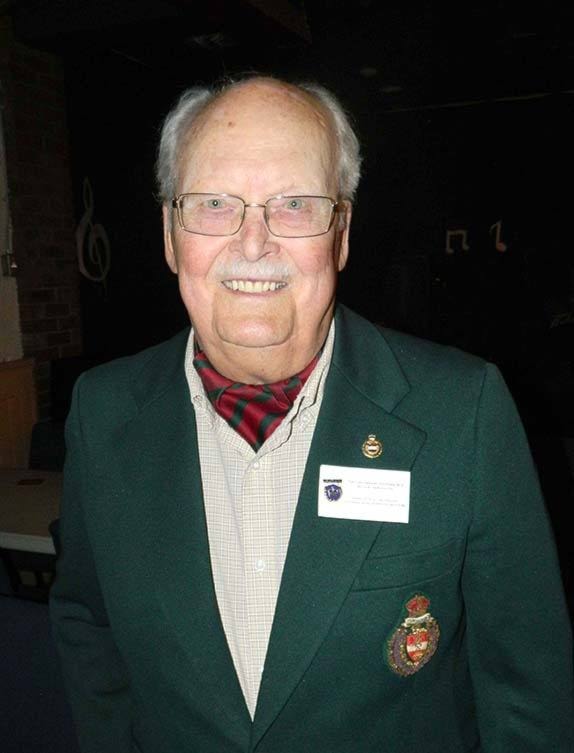The history of Cranbrook and a particular Canadian cavalry regiment are more interconnected than most people may realize. And if there is one individual who represents the Cranbrook spirit of Lord Strathcona’s Horse (Royal Canadians), it is Colin Anderson.
“Everyone should know the defense of Canada rests on this regiment,” said Anderson, who recently celebrated his 88th birthday at a party at the Royal Canadian Legion, Branch 24. “The Strathconas have been in every international war Canada has been involved in.”
The formation of Lord Strathcona’s Horse (Royal Canadians) involves two individuals who featured prominently in this area: Donald Smith (First Baron Strathcona and Mount Royal), renowned among other things for driving the Last Spike of the Canadian Pacific Railway at Craigellachie, B.C., near Revelstoke; and Sam Steele, who served as North-West Mounted Police detachment commander at Fort Steele.
When the Boer War began in 1899, Strathcona took it upon himself, with the blessing of the Canadian government, to form and outfit a brand new regiment out of Cranbrook. One of Strathcona’s stipulation was that he have a say in personnel recruitment, and he insisted on Sam Steele being the regiment’s first commanding officer. And so the regiment Lord Strathcona’s Horse (Royal Canadians) came into being in 1900 (the “Royal Canadians” was added at the insistence of the Canadian government).
The Strathconas were initially a cavalry regiment, which of course had evolved into an armoured regiment — tanks — by the Second World War (the Strathcona saw a lot of hard fighting in the Italian campaign of WWII, moving to France some time after D-Day).
Anderson himself enlisted in 1947. Originally from Saskatchewan, he moved to Currie Barracks in Calgary to join the Strathconas.
Anderson served in the same troop (of 32 personnel), as a tanker. He ultimately ended up as a tank crew commander.
A notable event in Anderson’s military career was his and his unit’s participation as peacekeepers in Vietnam in 1954, shortly after the Battle of Dien Bien Phu, in which the Viet Minh communist-nationalist revolutionaries dealt a crushing defeat to the French Union’s French Far East Expeditionary Corps, effectively ending France’s colony experience in Vietnam. Chinese forces had also invaded Vietnam, from the north.
“There were still French prisoners (at Dien Bien Phu) when we were there,” Anderson said. “Medical supplies were still being flown into them.”
Vietnam was just in the process of being divided into North Vietnam and South Vietnam. Anderson’s unit was stationed in Hanoi.
“Our job was to basically keep those people who didn’t want to be communist separated from the communists,” he said. The Strathconas helped transport civilians from the communist controlled areas to the port city of Haiphong, from where they would be transported down the coast to Saigon.
Anderson added that he developed a taste for Vietnamese cuisine while in Southeast Asia.
After his tour in Vietnam, Anderson’s regiment returned to Calgary, where he was involved in combat battle training. “(The Sarcee area of Calgary) was open prairie in those days,” Anderson said. “Good for tanks. It’s all developed now.”
After the Second World War the Strathconas used the Sherman, an American tank. “Towards the end of my 10-year service, they switched to a British tank, the Centurion,” Anderson said. “It was better.”
Anderson moved to Cranbrook in 1960, shortly after leaving the service, and his regimental pride and involvement remained undiminished over the years. He was involved with Army Cadets for 28 years after his regular service ended, and was instrumental in bringing the Lord Strathconas presence back to the city of its birth when, after discussions with the Strathconas’ commanding officer, the Cranbrook Army Cadets became affiliated with the Lord Strathcona’s Horse (Royal Canadians).
In the 1970s, the Lord Strathconas were awarded the Freedom of the City of Cranbrook — and thus are the only unit allowed to march in the streets of Cranbrook with bayonets fixed. “And we did just that,” Anderson said, “with two squadrons and a riding troop.”
One of the aspects of his life in Cranbrook has been his involvement with the Royal Canadian Legion, Branch 24. He has served as Branch President four times and Zone Commander twice.
Anderson also spearheaded the creation of the Wall of Honour, the war memorial in Cranbrook’s Rotary Park. Working with artist Joseph Cross, he made sure the mural on the east side of the wall included a depiction of Sgt. Arthur Richardson, who was awarded Canada’s first Victoria Cross while serving with the Strathconas in the Boer War.
“I have been awarded every award that headquarters in Ottawa can offer,” he said. “I’m the only one in the East Kootenay who has.”
Anderson says that that experience, and the experience of other veterans, must be taken into account in Legion decisions. “I say listen to that experience, and take it for what its worth.”
The Remembrance Day ceremonies, for example, which Anderson says should be based more on the National Ceremony in Ottawa.
“I’ve been to 45 Remembrance Day ceremonies at the Cenotaph,” he said. “They are very well attended here — there should be more crowd control and organization, and the Legion must make the decisions, not the invited dignitaries.”
Anderson also understands how times have changed for the Legion, how the organization has fallen on harder times, how younger veterans, like those who’ve served in Afghanistan, don’t make the Legion their home the way older veterans did.
But the importance of the Legion, the work it has done, and the postive impact it has had on individual lives, including his own, must not be forgotten, he said.
“The Royal Canadian Legion has done an awful lot of work for every community in this country.”
